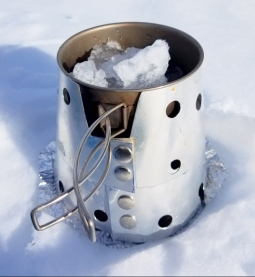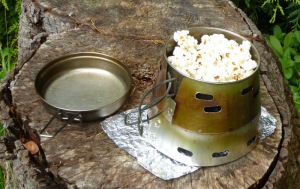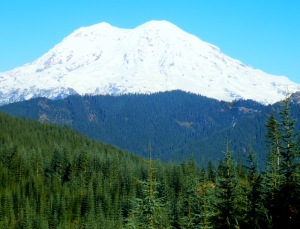 During a break in our seemly endless series of Pacific Northwest winter rains/snows, I took a day snowshoe hike on a familiar ridge in Mt. Rainier National Park. It seem like a good day for a stove experiment. Normally on winter outings, I take along a 20 oz. capacity stainless steel thermos, fitted with a reflective foil insulating wrap. At lunch, even in winter, it provides steaming hot water for instant espresso spiked hot chocolate drinks. On this trip, I opted to leave the thermos behind and take my small solo stove setup based on a Toaks 750 ml. titanium pot and windscreen to provide the heat. That meant I could forgo the normal cold sandwich and have my favorite trail hot meal – Annie’s Microwave
During a break in our seemly endless series of Pacific Northwest winter rains/snows, I took a day snowshoe hike on a familiar ridge in Mt. Rainier National Park. It seem like a good day for a stove experiment. Normally on winter outings, I take along a 20 oz. capacity stainless steel thermos, fitted with a reflective foil insulating wrap. At lunch, even in winter, it provides steaming hot water for instant espresso spiked hot chocolate drinks. On this trip, I opted to leave the thermos behind and take my small solo stove setup based on a Toaks 750 ml. titanium pot and windscreen to provide the heat. That meant I could forgo the normal cold sandwich and have my favorite trail hot meal – Annie’s Microwave  White Cheddar Mac & Cheese with some maple flavored bacon jerky bits thrown in for good measure, plus the normal mocha hot drink. My little stove setup is designed to be fired either with alcohol or Esbit tablets, which were the choice for this trip. Continue reading
White Cheddar Mac & Cheese with some maple flavored bacon jerky bits thrown in for good measure, plus the normal mocha hot drink. My little stove setup is designed to be fired either with alcohol or Esbit tablets, which were the choice for this trip. Continue reading
Tag Archives: Esbit tablets
Melting Snow with an Alcohol Stove
 One of the important issues in winter camping is procuring water. Typically that means melting snow. This requires a lot of fuel and a stove/fuel combination that works well in cold weather. For may years, conventional wisdom recommended pumped white gas stoves. More recently, pressure regulated, iso-butane canister stoves have gotten the nod as long as it isn’t really! cold. The venerable classic Mountaineering – The Freedom of the Hills, now in its 9th edition, states that alcohol as a fuel is best for “Ultralight cooking on long trips where melting snow or ice is not required.” Five years ago, I posted about winter/snow camping. Most of the post focused on the challenges of adding a 4th season to your outdoor trips, but also I used an alcohol stove for melting snow. It worked and since then I have built more stove/windscreen combinations and wondered if the changes I was making might also improve snow melting. So on a recent nice February day I went snowshoeing to find out. Continue reading
One of the important issues in winter camping is procuring water. Typically that means melting snow. This requires a lot of fuel and a stove/fuel combination that works well in cold weather. For may years, conventional wisdom recommended pumped white gas stoves. More recently, pressure regulated, iso-butane canister stoves have gotten the nod as long as it isn’t really! cold. The venerable classic Mountaineering – The Freedom of the Hills, now in its 9th edition, states that alcohol as a fuel is best for “Ultralight cooking on long trips where melting snow or ice is not required.” Five years ago, I posted about winter/snow camping. Most of the post focused on the challenges of adding a 4th season to your outdoor trips, but also I used an alcohol stove for melting snow. It worked and since then I have built more stove/windscreen combinations and wondered if the changes I was making might also improve snow melting. So on a recent nice February day I went snowshoeing to find out. Continue reading
Gear Trials – A Comfort light trip in Mt. Rainier NP
After a new ship is launched, it gets to meet the ocean for the first time with “sea trials”. As our parks reopen and snow leaves the high country, it was time to get out for gear trials with recent projects. I headed for a Park camp adjoining a couple of sub-alpine lakes at about 4700′. The forecast was for a nice day, followed by a weak front overnight with a chance of rain in the morning. As the first backpack of the season, I wanted to reality test my current set-up. I had finished a new tent – the Hex-Lite. My ultra-light bivy would serve as a quilt and air pad cover. I was planning to Esbit cook with a single pot. It was time to test a new Therm-a-Rest NeoAire Xlite air pad. My Big Agnes pad no longer held air overnight and was 6 years old. New gear keeps betting better. The Therm-a-Rest, with pump sack weighs only 15 oz., a 5 oz.  improvement.
improvement.
My claim for Comfort light backpacking is a 15 lb. base weight. For this trip, my actual was 16 lbs. – close enough. With overnight food and water, I left the car at 21 lbs. (I don’t really count fuel separately anymore, since for this trip it was 3 Esbit tabs – 1.5 oz.) Everything packed easily into my 2800 cu. in (46 L) RayWay pack, with the extension collar almost completely rolled down on top. Now over 7 years old, it is still a very comfortable pack to carry. Continue reading
Making an ultralight titanium multi-fuel windscreen
 I continue to be a big fan of titanium for ultralight applications. A cylindrical titanium windscreen might make a ultralight, minimalist cooking kit. This one was easy to build, weighs just 52 g. with two titanium stakes that serve as pot support and pin the windscreen closed. It is sized to work with a Toaks 750 ml. titanium pot and either an Esbit tablet or alcohol burner. On the trail, it seems a rugged and solid performer
I continue to be a big fan of titanium for ultralight applications. A cylindrical titanium windscreen might make a ultralight, minimalist cooking kit. This one was easy to build, weighs just 52 g. with two titanium stakes that serve as pot support and pin the windscreen closed. It is sized to work with a Toaks 750 ml. titanium pot and either an Esbit tablet or alcohol burner. On the trail, it seems a rugged and solid performer
I started with some titanium sheet from Ruta Locura. The windscreen has 5/8″ holes around the base on the handle cutout side. When the windscreen is rolled and pinned, 3 of the 8 holes overlap to give adequate combustion air inlet. Stake height is set at 3″ to place the pot high enough above  the tablet for good combustion. Overall, the windscreen is 6″ tall by 24″ long, with a 5″ diameter as assembled. In use, place the handle cutout and combustion holes away from any wind.
the tablet for good combustion. Overall, the windscreen is 6″ tall by 24″ long, with a 5″ diameter as assembled. In use, place the handle cutout and combustion holes away from any wind.
A bottom sheet of folded kitchen aluminum foil completes the combustion space. The Esbit tablet sits in a Trail Designs Gram Cracker holder. Under the holder is a little Ti pan, folded out of Ti scrap from the windscreen stock to contain any Esbit flare ups. Continue reading
In the mountains with a Kovea Spider Stove, Flat Cat Gear and blueberries
 In January I posted my first impressions and tests of the Kovea Spider stove. I tested it in my backyard with my collection of pots and windscreens to bake bread and make reasonable pancakes. This summer, the stove has accompanied me on a number of climbs and backpack trips and I have used it with some of Jon Fong’s Flat Cat Gear accessories. It’s good stuff.
In January I posted my first impressions and tests of the Kovea Spider stove. I tested it in my backyard with my collection of pots and windscreens to bake bread and make reasonable pancakes. This summer, the stove has accompanied me on a number of climbs and backpack trips and I have used it with some of Jon Fong’s Flat Cat Gear accessories. It’s good stuff.
If you spend time in the field, you know that many things must come together for a good kitchen kit. Weight, of course, is important. Packing volume also counts. And you must be able to do the cooking you want in real backcountry and mountain conditions. My kitchen is built around three pots, the 1 L and .78 L Ti pots of a Snow Peak Multicompact set and a 0.6 L Snow Peak Ti mug. I need windscreens to match the pots and the stoves I plan to use for any particular trip. For solo and individual cooking on group trips, I usually stick with the .78 L Snow Peak pot. For couples backpacking, the 1 L pot does most of the work, and I often take a second pot to have something clean for heating water after cooking. So any new stove must be properly introduced to these pots and find a way to work and travel efficiently with them.
 My first trials with the Kovea Spider were focused on baking and I used the big 1 L Snow Peak pot and its matching Trail Designs Caldera Cone Ti windscreen. It worked well, but the windscreen doesn’t pack into a pot. On some higher alpine climbs this summer, I took the Spider and my smaller .78 L pot, together with a split cone windscreen I had been using with an alcohol burner. It worked, sort of. Then I had a chance to try out some Flat Cat Gear windscreens designed just for the Kovea stove for a much better solution.
My first trials with the Kovea Spider were focused on baking and I used the big 1 L Snow Peak pot and its matching Trail Designs Caldera Cone Ti windscreen. It worked well, but the windscreen doesn’t pack into a pot. On some higher alpine climbs this summer, I took the Spider and my smaller .78 L pot, together with a split cone windscreen I had been using with an alcohol burner. It worked, sort of. Then I had a chance to try out some Flat Cat Gear windscreens designed just for the Kovea stove for a much better solution.
For larger pots, the Flat Cat Bobcat Kovea windscreen is a winner. Continue reading
Ultralight Backpacking Fuels, Alcohol and Esbit – Insights from the field
 Alcohol stove fuel and Esbit tablets really can be the workhorses of ultralight cooking. The usual canister vs. alcohol vs. Esbit review doesn’t really capture practical or best practices approaches to these two fuels. Here are my tips on how I make these fuels work well for me in my backcountry kitchen to boil water, to rehydrate a freeze dried meal or bake a chocolate cake. Even in the rain.
Alcohol stove fuel and Esbit tablets really can be the workhorses of ultralight cooking. The usual canister vs. alcohol vs. Esbit review doesn’t really capture practical or best practices approaches to these two fuels. Here are my tips on how I make these fuels work well for me in my backcountry kitchen to boil water, to rehydrate a freeze dried meal or bake a chocolate cake. Even in the rain.
It’s not just the fuel, but really the whole system that counts. That includes fuel, burner, pot support, windscreen, simmer control, stove lighting and extinguishing, burn time, outdoor temperature sensitivity, refueling ease, fuel storage and some factor for operating fussiness. Add to this weight and cost considerations for both the basic system and for fuel and you will be well on your way to making choices. Some popular stove products do a good job on addressing most issues, think Jet-Boil. See how I do better. Continue reading
Popcorn!
 I was reading an old back country cookbook recently and came across the concept of making popcorn in the woods. For some reason, the idea had never occurred to me, but a quick check of the cyber sphere revealed many YouTube posts of the process. O.K then, I had to try it with my setup. As you can seem, it works, but more about that later.
I was reading an old back country cookbook recently and came across the concept of making popcorn in the woods. For some reason, the idea had never occurred to me, but a quick check of the cyber sphere revealed many YouTube posts of the process. O.K then, I had to try it with my setup. As you can seem, it works, but more about that later.
Some posts ago I blogged about the “Price of Nothing”. Look it up in the Archives if you’re interested, but it was about the money spent to save a little weight. The spirit of this post is the opposite – how little extra weight can you carry to enjoy something new or additional in the outdoors. Popcorn is classic “comfort light” at just 2.7 oz. for the trip and 1.1 oz. per serving. Here’s how. Continue reading
End of season review
 Mt. Rainier is now wearing a new coat of snow and the high country is making the transition to winter. Days are short, the rain is arriving and it is time to look ahead to ski season. This is a good time to reflect on this year’s outings. What worked well? What didn’t?
Mt. Rainier is now wearing a new coat of snow and the high country is making the transition to winter. Days are short, the rain is arriving and it is time to look ahead to ski season. This is a good time to reflect on this year’s outings. What worked well? What didn’t?
Comfort light delivered for me this season. Good, light weight equipment continues to open opportunities. My wife and I are backpacking again, without me as the mule. I am able to do grab and go trips to support climbs requiring a base camp. Bake a load of Logan bread. Take a quick shopping trip and I am off. With less gear, packing is quicker. In the past even overnight trips seemed to have packing drama. Continue reading
Favorites, part 1
This section covers my “people’s choice awards”. Items here just really work and show outstanding design.
Long handled titanium spoon
 I have owned this spoon for a number of years. I originally found it on a cottage ultra-light website, but now even REI carries something similar. Mine is polished, which I like better than darker, unfinished titanium.
I have owned this spoon for a number of years. I originally found it on a cottage ultra-light website, but now even REI carries something similar. Mine is polished, which I like better than darker, unfinished titanium.
The design allows you to eat out of freezer bags. I don’t do this, but I will eat out of pots, where the long handle helps. I like the hard titanium for stirring food off the bottom of pots during simmering. The spoon is tough and cleans up easily. It is too long to pack into most cooking kits, but I always have somewhere to keep it. At 1.2 oz. it earns it’s keep in my kitchen. Continue reading
Dry baking
 Freshly baked food is a hit in the outdoors. The means to this delicious end are many. I remember twisting dough onto a stick and roasting it over an open fire as a Boy Scout. With open fires, reflector ovens and Dutch Ovens have a great history. Fry bread and bannock cooked over open fires or stoves also have their place. However, when open fires and heavier cooking gear are no longer part of the picture, baking becomes more difficult.
Freshly baked food is a hit in the outdoors. The means to this delicious end are many. I remember twisting dough onto a stick and roasting it over an open fire as a Boy Scout. With open fires, reflector ovens and Dutch Ovens have a great history. Fry bread and bannock cooked over open fires or stoves also have their place. However, when open fires and heavier cooking gear are no longer part of the picture, baking becomes more difficult.
The reward for solving this problem – fresh baked backpacked food – is so compelling that a number of light weight solutions have emerged. Continue reading

